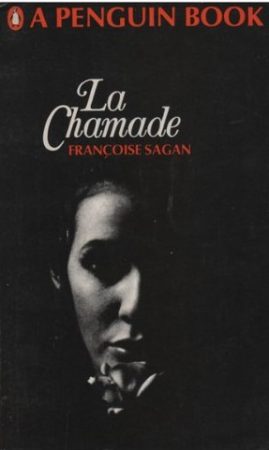
La Chamade by Francoise Sagan was written in 1965
La chamade is a battle drumbeat, rapid and rattling, beaten “at the moment of surrender.” Over time, chamade became synonymous with heartbeat, the kind that accompanies flushed cheeks and widened eyes and the sense that the world will never be the same after him. In 1969, Jean Paul Guerlain created one of the house’s greatest perfumes in homage to Francoise Sagan’s novel, La Chamade, about a young woman torn between her wealthy, older lover and a breathless romance with a man her own age.
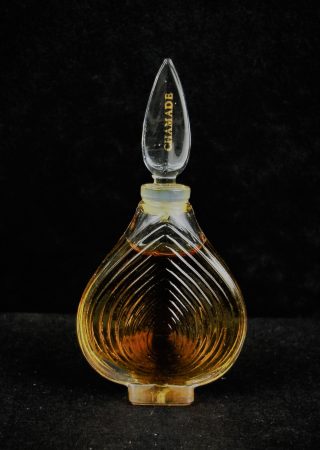
Guerlain Chamade Parfum flacon via Guerlain
Originally housed in an elegant heart-shaped bottle designed by Raymond Guerlain, Chamade is a stunning creation, but it has a certain remoteness, achieved by the spray of cold glitter in the top, which I gather is hedione rather than aldehydes, and ashy orris and lilac in the center. In this sense, it is not unlike Sagan’s Lucile, particularly as she is played by the unreachably beautiful Catherine Deneuve in the 1968 film version. The crisscross between cool and warm notes throughout Chamade’s trajectory references its heroine’s emotional dilemma: will she take the warmth of love or the coldness of prestige? The chill of a life of poverty with the man she loves or the warmth of financial security with Charles? The cold shimmer that overhangs Chamade, even as its ambery-vanillic base comes through, suggests Lucile’s choice.
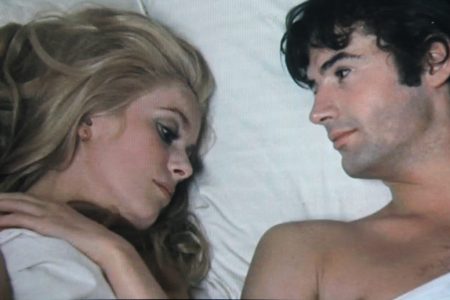
Catherine Deneuve and RogerVan Hool in the movie version of La Chamade (1968-movie still)
In its earliest moments, Guerlain Chamade EDT is an inhalation of spring, of newness, of nascent flowers exploding into bloom, of greenery shooting through the chilly soil under a wan sun. It is also a master class in composition; its profusion of florals and green notes are as precise as etched glass, balanced and delineated but completely cohesive, like a corps de ballet. I own two versions, both vintage: the first, an EDT from the early 1980s; the second a parfum from the 1990s.
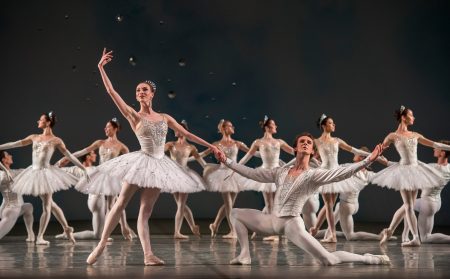
New York City Ballet in Diamonds from Jewels by George Balanchine, photo by Stephanie Berger
Chamade EDT is like wandering into a bower tumbling with jasmine, hyacinth, lily-of-the valley and lilacs when suddenly the breeze stirs the blossoms like fragrant wind chimes. In those first few minutes, Chamade seems a scent for a sophisticated young woman – or one trying to become so – but then, it glints with a touch of knowing cruelty. The lushness of one of the most lovely hyacinth notes in all perfumery rises in a heady cloud, but, as it gathers intensity, the flower is pierced by a stiletto of galbanum, so sharply green it seems to slice through the air.
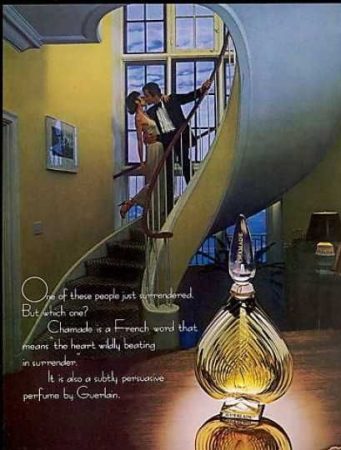
Guerlain Chamade Parfum ad, 1980s
Later, when the galbanum and hyacinth subside, Chamade begins to thaw. A chirpy blackcurrant note comes out, and the oriental base of amber and vanilla – echoed by benzoin and tonka – comes forward. The famous guerlinade – Guerlain’s trademark accord, said to contain bergamot, rose, jasmine, tonka bean, iris, and vanilla – rounds the fragrance and softens it at different moments. I get iris and bergamot near the top, jasmine and rose in the middle (the latter almost into the dry-down) vanilla and tonka in the base. The gradual release of these characteristic notes embroiders the Guerlain signature into Chamade’s chiffon fabric without distracting.
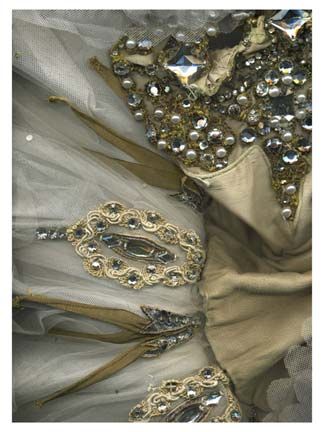
Detail of Karinska original costume for New York City Ballet Jewels, photo New York City Ballet
Where Chamade EDT sparkles like a diamond collar, the parfum glows like a cabochon. Far richer than the EDT, as you would expect, the exquisite parfum has a poignancy the EDT lacks. Both perfumes strike me as balletic; the EDT, like the opening of Giselle, joyous leaps and girlish pirouettes, the parfum like the third movement of Balanchine’s masterpiece, Jewels: resplendent, classical and starry. In the top of the parfum, huge sprays of lilac and hyacinth twine with lily of the valley and powdery orris. The orris is much more noticeable here, the hyacinth so opulent it is like inhaling a new-cut bouquet of those curly flowers. And, unlike so many other perfumes, the hyacinth stays true even through the dry-down, never becoming soapy or shrill. While galbanum is there, it is muted, allowing bergamot and juicy blackcurrant to dot the florals with piquant touches. The parfum warms up sooner than the EDT (which never quite leaves the galbanum long enough for the base notes to prevail) and stirs ylang ylang into the center like a deliciously tropical bonbon. In the EDT, I notice the ylang less and jasmine and sandalwood more.
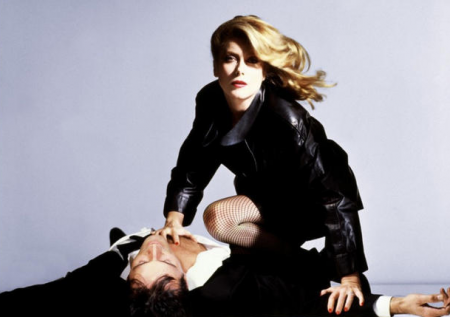
Catherine Deneuve in The Hunger, 1983 still MGM
Which version is more beautiful? That depends on whether you find Catherine Deneuve lovelier as Lucile or, perhaps, as Miriam in The Hunger.
When I first arrived in Oxford, lines from Evelyn Waugh’s Brideshead Revisited echoed in my ears with every cobbled step. In my head was a collage of visions of study groups under gothic eaves, fancy dress parties, strawberries and champagne, picturesque eccentrics wandering the High Street and banks of wildflowers along the Cherwell. Whether any of that proved true or not, I came armed with my cap and gown, a volume of Shakespeare and a bottle of the most glamorous perfume I could find, what would become my ball gown scent forever, Guerlain Chamade.
Notes: Bergamot, hyacinth, galbanum, blackcurrant bud, rose, jasmine, lilac, lily of the valley, clove, ylang ylang, vanilla, tonka, amber, benzoin, sandalwood, vetiver, orris, ambergris.
Disclaimer: Both Chamade parfum vintage and Chamade EDT vintage from my own collection.
Lauryn Beer, Senior Editor
Have you worn Chamade in the EDT or the Parfum Version?
